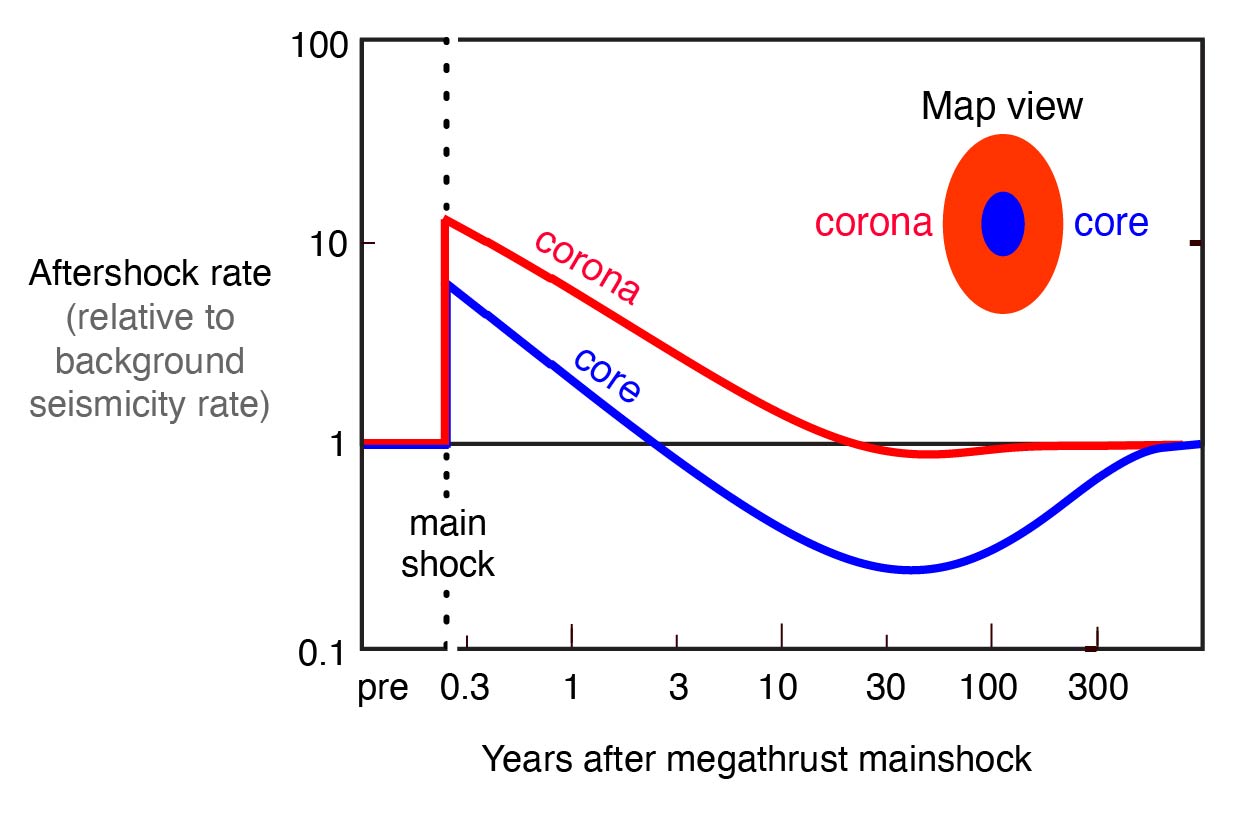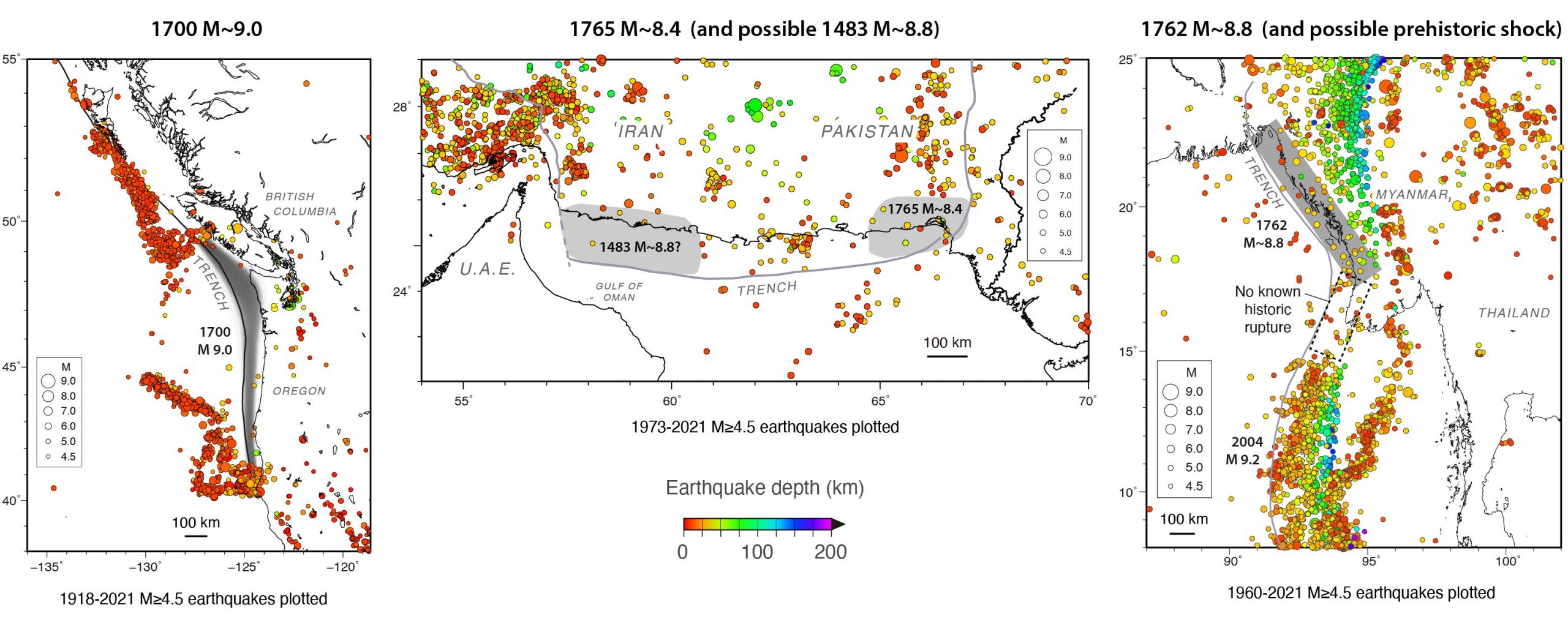Aftershocks of large earthquakes can be highly destructive. New evidence has emerged of both a shutdown and a persistence of such shocks following megathrust events throughout history.
Ross S. Stein, Ph.D., Temblor, Inc., and Shinji Toda, Ph.D., International Research Institute of Disaster Science, Tohoku University
Citation: Stein, R. S., Toda, S., 2022, Megathrust earthquakes impact surrounding seismicity for centuries, Temblor http://doi.org/10.32858/temblor.260
Subduction zones spawn the planet’s largest earthquakes, termed ‘megathrusts’ once they reach magnitude-9. Such shocks release one thousand times the energy of a magnitude-7 event, and thus play a dominant role in the global seismic energy release. However, they occur at a rate only one hundredth of a magnitude-7. On average, there are about five megathrust shocks per century (Kagan and Jackson 2013). The largest instrumentally recorded megathrust was the 1960 Valdivia, Chile, magnitude-9.5 event.
Most seismic hazard assessments attempt to reflect the long term earthquake rates, which are assumed to slowly change as stress builds on faults. But there is abundant evidence that megathrusts and other very large earthquakes abruptly and profoundly alter the hazard to depart, leading to damaging aftershocks and progressive mainshocks.
In a study published last week in Nature Geoscience, we argue that after a megathrust earthquake, aftershocks on the rupture surface quickly shut down. At the same time, large aftershocks light up the surrounding area, menacing coastal population centers.
Aftershock core and corona
Within five years of each megathrust shock that struck since 1960, aftershocks on the high-slip portions of the rupture surface had shut down. This includes the 1960 magnitrude-9.5 Valdivia, 1964 magnitude-9.2 Prince William Sound, 2004 magnitude-9.2 Sumatra and 2011 magnitude-9.0 Tohoku earthquakes. It is probably also the case for the somewhat smaller 2010 magnitude-8.8 Maule, Chile, quake. In these “cores,” seismicity rates dropped well below the rate observed in the decades before the megathrusts. Immediately after each of these events, a surrounding “corona” of seismicity was activated, and continues to be active today — up to 60 years later. Owning to Japan’s unsurpassed seismic monitoring network, the best recorded of these is the 2011 magnitude-9.0 Tohoku shock.

Coulomb stress transfer can explain these observations
These observations can be explained by the transfer of stress during an earthquake — known as Coulomb stress transfer. Earthquakes generally release the built up stress on the fault that slipped, transferring it to surrounding faults. In the Coulomb hypothesis, both an increase in shear stress and unclamping of a fault promote failure, whereas reducing the shear stress or clamping the fault inhibit failure. These stresses cause seismicity, the rate of which evolves through time (Dieterich, 1994; Stein, 1999). Most corona aftershocks occurred because the faults on which they struck were brought immediately closer to Coulomb failure by the mainshock rupture, suggesting that the corona is a product of stress transfer from the rupture to surrounding faults. In contrast, in the core, the Coulomb stress inhibited most aftershocks. Some faults within the core experience a stress increase, causing a sudden rise in seismicity rate. But these sites are rapidly consumed as aftershocks release this stress, resulting in a delayed shutdown.

Implications for seismic hazard
Because the corona is as much as ten times larger than the core, there is a net hazard increase after a megathrust that lasts for about half a century, typically spanning the trench to the coast. Most hazard models, including the “seismic gap theory,” instead assume that the hazard drops after a megathrust. Four roughly magnitude-7 earthquakes struck along the Tohoku coast in 2021-2022 — more than a decade after the mainshock — all in corona areas. We regard these as Tohoku aftershocks, rather than run-of-the-mill earthquakes. In support of this interpretation, there were 22 magnitude-6.7 and greater shocks in the decade after the Tohoku mainshock, but only 4-5 in the same area in the decade beforehand — a four-fold rate increase. In addition, at the site of the magnitude-7 shocks, the rate of small (magnitude-3 and larger) shocks is five times higher today than it was before the 2011 shock. So, in our view, the model exhibits a forecast skill that could be used to improve hazard assessments. In addition to Japan, Chile and Indonesia also suffered megathrusts, which strongly alter their seismic hazard today.
A new way to hunt for prehistoric megathrusts
If our model is correct and the core shutdown persists for 300 or so years, then we should be able to find sites of pre-instrumental and prehistoric megathrust earthquakes by searching for current holes in subduction zone seismicity. All four of the megathrusts since 1960 are visible today as seismicity holes, as are the still older 1868 magnitude-9.1 Arica (Peru-Chile), 1762 magnitude-8.8 Arakan (Myanmar) and 1700 magnitude-9.0 Cascadia (US-Canada) earthquakes. Candidate prehistoric megathrust ruptures include a 200-mile-long (300-kilometer) hole along the western Makran Trench and 400-mile-long (700-kilometer) hole along the Commander section of the northwest Aleutian arc.

This view is opposite to what most researchers have assumed. Holes have been interpreted as aseismic sections of subduction zones, where megathrusts are not possible. But where aseismic slip, known as “creep,” is independently documented from GPS measurements, it is generally accompanied by moderate seismicity, so these are not seismicity holes. In fact, the Juan de Fuca Trench off the Pacific Northwest was assumed to be permanently aseismic until Brian Atwater and Kenji Satake discovered evidence for the 1700 Cascadia tsunami (Atwater et al. 2016).
What about the San Andreas?
Whether seismicity holes might also mark the sites of historic and prehistoric magnitude-8 transform fault ruptures is uncertain. Tantalizingly, the sites of the great 1857 magnitude-7.9 southern San Andreas and 1906 magnitude-7.7 northern San Andreas earthquakes are holes today (Scholz 1988). But because these transform (strike-slip) earthquakes are so much smaller than megathrusts, the seismicity data needed to demonstrate this case worldwide is impoverished, and so the answer remains clouded.
References
Atwater, B.F., Musumi-Rokkaku, S., Satake, K., Tsuji, Y., Ueda, K. and D.K. Yamaguchi (2016), The orphan tsunami of 1700: Japanese clues to a parent earthquake in North America. University of Washington Press (USGS Prof. Paper 1707).
Dieterich, J. H. (1994), A constitutive law for the rate of earthquake production and its application to earthquake clustering. J. Geophys. Res. 99, 2601-2618, https://doi.org/10.1029/93JB02581
Kagan, Y. Y., and D. D. Jackson (2013), Tohoku Earthquake: A Surprise? Bull. Seismol. Soc. Am. 103, 1181–1194. doi: https://doi.org/10.1785/0120120110
Obana, K., M. Scherwath, Y. Yamamoto, S. Kodaira, K. Wang, G. Spence, M. Riedel, H. Kao (2014), Earthquake activity in northern Cascadia subduction zone off Vancouver Island revealed by ocean‐bottom seismograph observations. Bull. Seismol. Soc. Am. 105, 489–495. doi: https://doi.org/10.1785/0120140095
Toda, S. and R. S. Stein (2022), Central shutdown and surrounding activation of aftershocks from megathrust earthquake stress transfer, Nature Geoscience, doi: https://www.nature.com/articles/s41561-022-00954-x. Or freely available from ShareIt https://rdcu.be/cPoHx
Scholz, C.H. (1988), Mechanisms of seismic quiescences. Pure Appl. Geophys. 126, 701-718, https://doi.org/10.1007/BF00879016
Stein, R. S. (1999), The role of stress transfer in earthquake occurrence, Nature 402, 605-609, https://doi.org/10.1038/45144
- Earthquake science illuminates landslide behavior - June 13, 2025
- Destruction and Transformation: Lessons learned from the 2015 Gorkha, Nepal, earthquake - April 25, 2025
- Knock, knock, knocking on your door – the Julian earthquake in southern California issues reminder to be prepared - April 24, 2025
